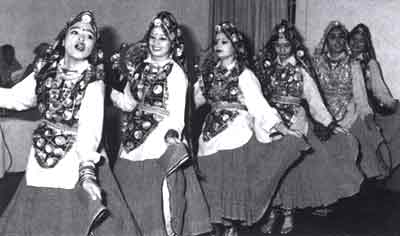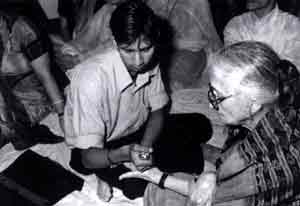

Hariyali Teej in IGNCA
The Janapada Sampada (JS) division of Indira Gandhi National Centre for the Arts celebrated its Foundation Day –Hariyali Teej on August 1st, 2003. Dr Kapila Vatsyayan, one of the founders and pillars of the instituion, was the chief guest. The celebrations began with the puja of the nyagrodha (Ficus Bengalensis) tree as per the continuing tradition of the division. The puja conducted by Pandit Vijay Shankar Shukla was performed by Smt. Parveen Shah. Prof. Gaya Charan Tripathi, Co-ordinator, Kala Kosa, composed a very meaningful verse on the divine virtues of the nyagrodha.
In his welcome address Prof. R.K. Bhattacharya, Head of JS Division said, “IGNCA was designed as an interlocking discourse, based on the full knowledge that there are many cultures and traditions that not only contribute to heritage but also enrich it. It has been the ambition of the JS division to understand very minutely the functioning of various communities in their totality.” He, however, added a word of caution. He said, “We will have to be clear about the relationship that exists between parts and whole.”
In its essence, the Haryali Teej is associated with the introspection and evaluation of the performance of the division during the year gone by Dr. Kailash Kumar Mishra presented a detailed account of the various events, programmes and publications. He briefly spoke about the significance of nyagrodha in our rituals and daily life and tried to relate their meaning with the aims and objectives of the IGNCA.
Janapada Sampada deals with research and documentation on the contextual aspects of culture including lifestyle, traditions, folklore and art practices of communities, from eco-cultural and socio-economic points of view. Concentrating on the oral traditions, it has a wide canvas covering regional studies from a multi-disciplinary perspective emphasizing the inter-relationships between different cultural groups and communities. The activities pertaining to this division are: (1) Ethnographic Collections (2) Multimedia Presentation and Events (3) Lifestyle Studies under which are Loka Parampara and Kshetra Sampada (4) Heritage Studies and (5) IGNCA Study Circle. A summary of each of the activity is as follows:
Ethnographic collection
Masks, puppets, textiles, art objects and paintings are among the material collected. These collections are getting documented, catalogued and digitized. Digitization of 600 masks and 350 puppets has been completed. Both will be released in CD-ROM form. Core data of 45 items of the Chikankari (Lucknow textiles), 1000 entries of Milada Ganguli collection of Naga art objects and information on 77 kalamkari paintings have been fed into the computer. Data entry of the photographs and other items of Brhadesvara Project has been initiated. Under manual documentation, 250 items of various collections on textiles, embroidery pieces and other artifacts, cataloguing and accessioning of 300 Rabari lifestyle articles and cataloguing of 600 slides of various Rock Art sites collections of some museums have been completed. No new acquisitions are being done now.
Multimedia Presentations and Events
The division has made important contributions towards the concept of the proposed twin galleries of Adi drsya and Adi srvya – a major programme of the Centre. The Janapada Sampada is gradually building up its material through its resource on rock art and many forms of music and sound. This year Dr. S.S. Toshkhani has submitted his first phase report of the project on “Rituals and Ritual Art of Kashmir”. He is working on the second part.
Lifestyle Studies
Loka Parampara: The following collaborative projects are finalized under this head: (a) “Traditional Knowledge System’ by Dr. D.P. Aggarwal; (b) `Tradition, Innovation and Authenticity in Folk Art and Ethnographic Study of Mithila Paintings’ by Dr. Mani Shekhar Singh; (c) `Samskar of the Hindu’ by Dr. Ramashray Ray and (d) `Food of the Siddi Tribe’ by Dr. V.N. Bhat.
The division has accepted four new projects: (a) `Anthropology of Space and Time: A case Study of the Santhal Tribe in the Birbhum District of West Bengal’ by Dr. Onkar Prasad; (b) `Folklore Verses Foloric Culture: The Relationship between print media and folk aesthetics in Purulia’ by Dr. Roma Chatterji; (c) `Puppetry of Orissa: Survey, Documentation and Research on Chaya Nataka’ by Dr. Itishree Sahoo and (d) `Documentation, Research and socio-Cultural Study of the Temple Cultural Materials of the Mandakini River Valley of the Garhwal Himalayas’ by Dr. M.K. Pal.
Kshetra Sampada:
(a) The Bhaktirasamrtasindhu, a Vaishnav text by Roopa Goswami has been translated into English by Dr. David Haberman and published jointly with Motilal Banarsidas Publishers; (b) The same text has been translated into Hindi by Late Dr. Premlata Sharma. Unfortunately she died when the book was about to be published. Now it is getting published under the academic guidance of dr. Urmila Sharma; (c) Proverbs and Folklore of Kumayun and Gahrwal by Late Prof. G.D. Upreti was reprinted with the collaboration of Concept Publishers.; (d) Dr. Urmila Sharma has initiated the editing of The Ujjalalanilamani, a Vaishnav text by Roopa Goswami; (e) The Iconography of Brihadisvara by Dr. R. Nagaswami has gone to the press for publication.
Heritage Studies
In order to create a sense of pride to retain the cultural aesthetics, very recently the division initiated a new programme on Heritage Studies. Under this, scholars can undertake innovative and needful projects to promote people’s concern to retain the tangible and intangible heritages of India. IGNCA has also constituted a sub-committee on Heritage Activity. Renowned artists, scholars of folklore, anthropology, art history, schoolteachers; principals, planners, architects etc are the members of the sub-committee. With their involvement, efforts are on to evolve a guideline to include Heritage Activity as a regular, curricular and evaluated subject for the schoolchildren from class 1 to 12. As part of this effort, the division organized a 15-day trainee teacher’s orientation workshop in art education in association with Parivartan – an NGO. Around 500 trainee teachers participated in the workshop.
Two volumes of the Sri Ramayan Mahaniveshnam – a text written in Kannada have been translated into Hindi and gone for publication to Rajkamal Prakashan.
Study Circle
The IGNCA Study Circle was mooted last year with the aim of organizing regular meeting of scholars of various disciplines and institutions. Research papers read by the scholars would be published by the IGNCA in the form of monographs. Some papers would also be considered as research articles in the IGNCA journal. This year Dr. Vasant Kumar Saberwal gave a lecture with his film on the Gaddis of Himachal Pradesh on August 13, 2003.
Besides this, all scholars of the division are working on their in-house projects. Given below is the list of the in-house projects:
“Cultural Categories of Space and Time” by Dr. Molly Kaushal; “Study and Documentation of Village Painting and Rock Art Sites in Central India” by Dr. B.L. Malla; “Thesaurus of Santhal Terms Concerning Body, Womb and Seed” by Dr. Nita Mathur; “Food and Ecology: A Study of Bajra” by Dr. Ramakar Pant: “Theatre as Manifestation of Subsistence Pattern of the Mountain Eco-Systems of the Central Himalyas” by Dr. Richa Negi and “Dimensions of Maithili Culture” and “Abbakka Rani: The Unsung Warrior Queen of Coastal Karnataka” – A Documentary film by Dr. Kailash K. Mishra.
Seminars/Workshops/Symposiums: During the year, three seminars were organized (a) International symposium on “Folklore, Public Space and Civil Society” -7-11th October, 2003 (in collaboration with National Folklore Support Centre, Chennai); (b) National Conference on “Cultural Heritage and Traditional Knowledge Base of the Indigenous Communities of North East India” -9-10th December, 2002 (in collaboration with IGNCA Field station at Guwahati); (c) National symposium cum workshop on “Village India” -5-7th May, 2003.
Dr. Kapila Vatsyayan congratulated Prof. Indra Nath Choudhuri, Prof. R.K. Bhattacharya and scholars of the division for their performance. She also explained the significance of the nyagrodha as a symbol of Janapada Sampada. “After the intense heat when all the leaves and branches of trees are dried, the rain comes and gives new life to them. All leaves and branches come alive and start breathing fresh with green atmosphere everywhere and in this rainy season, mainly on the day of Hariyali Teej, women come back to father’s house and adorn a freshness in their personality. She forgets every pain and hardship and sings the songs in the swing. A new beginning of life is initiated. So, the nyagrodha is treated as the symbol of matrishakti and hence it has been the symbol of the Janapada Sampada division.”
Prof. Indra Nath Choudhuri, Member Secretary IGNCA congratulated all the scholars and employees of the division for achieving the target.
The programme concluded with the joyful song and folk dance on the theme Hariyali Teej by a team from Rohtak, Haryana. Dr. Nita Mathur compeered the programme.
(Report by Dr. Kailash Kumar Mishra)




